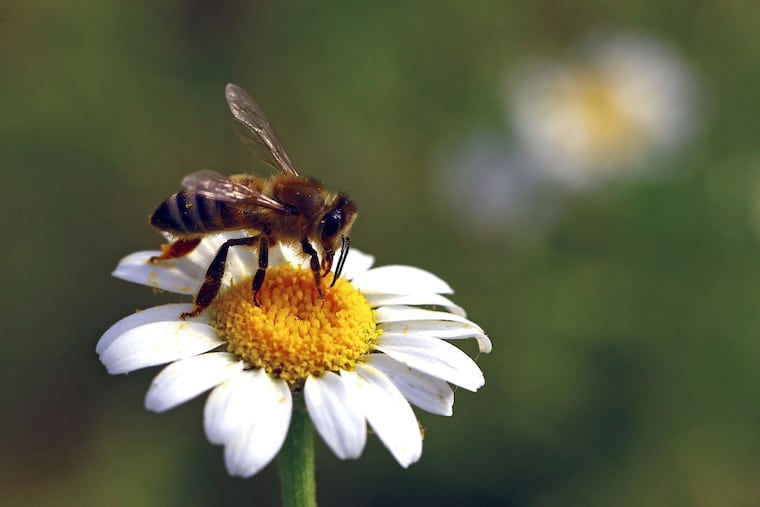As you plan your 2021 garden, pick plants that support bees, butterflies and ladybugs
Many beneficial insect species are declining and need humans’ help. If you’re looking for a new challenge this year, consider revamping part of your yard to help them.

As winter phases into spring across the U.S., gardeners are laying in supplies and making plans. And as the weather warms, common garden insects such as bees, beetles and butterflies will emerge from underground burrows or nests within or on plants.
Most gardeners know how beneficial insects can be for their plots. Flies pollinate flowers. Predatory bugs, such as the spined shoulder bug, eat pest insects that otherwise would tuck into garden plants.
As a scientist whose research involves insects and as a gardener, I know that many beneficial insect species are declining and need humans’ help. If you’re a gardener looking for a new challenge this year, consider revamping all or part of your yard to support beneficial insects.
Lawns are insect food deserts
Some gardeners choose native plants to attract and support helpful insects. Often, however, those native plants are surrounded by vast expanses of lawn, which the vast majority of insect species find as unappetizing as we would. NASA estimated in 2005 that lawns covered at least 50,000 square miles of the United States — about the size of the entire state of Mississippi.
A well-manicured lawn is a sure sign that humanity has imposed its will on nature. Lawns provide an accessible and familiar landscape, but they come at a cost for our six-legged neighbors. Grasses grown as turf provide very few places for insects to safely tuck themselves away, because homeowners and groundskeepers cut them short — before they send up flowering spikes — and apply fertilizers and pesticides to keep them green.
Entomologists have a recommendation: Dig up some fraction of your lawn and convert it into a meadow by replacing grass with native wildflowers. Wildflowers provide pollen and nectar that feed and attract a variety of insects such as ants, native bees and butterflies. Just as you may have a favorite local restaurant, insects that live around you have a taste for the flowers that are native to their areas.
This bold choice will not just benefit insects. Healthier insects support local birds, and meadows require fewer chemical inputs and less mowing than lawns. The amount of attention that lawns demand from us, even if we outsource the work to a landscaping company, is a sign of their precarity.
A meadow is a wilder, more resilient option. Resilient ecosystems are better able to respond to and recover from disturbances.
Entomologist Ryan Gott, integrated pest management and quality control specialist at Maitri Genetics in Pittsburgh, describes lawns and meadows as two opposite ends of a resiliency spectrum. “As far as basic ecological functions go, a lawn does not have many. A lawn mainly extracts nutrition and water, usually receiving outside inputs of fertilizer and irrigation to stay alive, and returns very little to the system,” he told me.
Native plants, by definition, will grow well in your climateand they provide a palette of colors and variety that lawns sorely lack. By planting them as a meadow, with many different flowers emerging throughout the growing season, you can provide for a diverse assortment of local insects. Meadows thrive in full sunlight, which is also where lawns typically do well.
Making insects feel at home
If you have a shady yard, consider modeling your garden after natural landscapes such as woodlands that are shady and also support insects.
What’s important in landscaping with insects in mind, or “entoscaping,” is considering insects early and often when you visit the garden store. With a few pots or window boxes, even a balcony can be converted into a cozy insect oasis.
If you don’t have a garden, you can still support insect health. Try replacing white outdoor lights, which interfere with many insects’ feeding and breeding patterns. White lights also lure insects into swarms, where they are vulnerable to predators. Yellow bulbs or warm-hued LEDs don’t have these effects.
Another easy project is using scrap wood and packing materials to create simple “hotels” for bees or ladybugs, making sure to carefully sanitize them between seasons. Easiest of all, provide water for insects to drink — they’re adorable to watch as they sip. Replace standing water at least weekly to prevent mosquitoes from developing.
A refuge in every yard
Many resources across the U.S. offer advice on converting your lawn or making your yard more insect-friendly.
The Xerces Society for Insect Conservation publishes a guide to establishing meadows to sustain insects. University extension offices, including at Rutgers and Penn State, post tips on insect-friendly yards, offering specific instructions and resources for their areas. Gardening stores often have advice and carry selections of local plants.
Humans all too often see ourselves as separate from nature, which leads us to relegate biodiversity to designated parks. In fact, we are an important part of the natural world, and we need insects just as much as they need us. As ecologist Douglas Tallamy argues in his book, Nature’s Best Hope, the best way to protect biodiversity is for people to plant native plants and promote conservation in every yard.
Brian Lovett is a postdoctoral researcher in mycology at West Virginia University. This article is republished from The Conversation under a Creative Commons license.